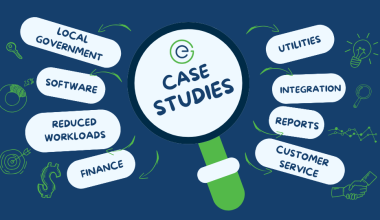Improving IT processes has been a core focus of local governments throughout the past year. You may not be aware of it, but business outcomes have a direct correlation with internal IT processes. When these subjects are in tune with one another, an organization can enhance decision making and cultivate desirable outcomes. This harmonious tune is known as IT governance.
What is IT Governance?
At first, IT governance might sound like something that should have been implemented in an action-packed 80’s movie to prevent a cyborg take-over. Thankfully, when it comes to local governments, IT governance does not need to be deployed to terminate a threat of that magnitude. This process can however strengthen an organization’s ability to strategize, especially when paired with the mindset to shoot for the sky to net important outcomes for municipalities. In short, IT governance connects IT with your business functions to accomplish desired results. It is a set of processes that your organization should consider implementing to ensure that your IT initiatives are strategically aligned with your business goals.
How Does it Function in Local Government?
Impactful IT governance in local government is built around making informed decisions that bolster IT efforts along with measuring the decision’s outcomes. Metrics by which those outcomes are measured should be related to both IT and business key performance indicators. Decision-makers and influencers involved with the IT governance team should be clearly defined to continually build a well-rounded structure and keep a concise communication channel open. Team members on an IT governance team may consist of individuals such as Finance Directors, Treasurers, IT Directors, and strategic decision-makers like elected Board Members or Supervisors.
How Does It Improve the Decision-Making Process?
The IT governance team should consider which IT projects to pursue and how to prioritize the most important projects. Special consideration should be given to how the IT projects align with other key initiatives. Additionally, discussions on how to invest budget dollars to support short-term and long-term goals of the municipality should also be relevant.
As an example, in the last year we saw an urgency from municipal governments to move to a remote work environment and provide remote services. There was a higher need to invest in cloud applications, improve cybersecurity solutions, and increase the availability of online solutions to deliver citizen services. When working with our clients, we found initial decisions made by municipalities during the start of the pandemic were done so to act quickly without fully considering how it may impact their organization. Many municipal governments did not have an IT Director or third party in place to help them navigate through the challenges that arose during the pandemic. With our evaluations and IT governance insights, they were able to fully understand the scope of their options. Whether it was providing citizens with online self-service portals or implementing new ERP software to increase remote productivity, these options proved to be great ways to counter-act the challenges spurred by the pandemic. It also set organizations on the right path for the future and improved their evaluation processes.
If your current IT process is fragmented and inconsistent, you should consider looking into IT governance solutions to help reduce risk and drive better outcomes. Third party IT services are available to co-manage or fully-manage municipal government IT functions that include planning, communicating, and delivering IT initiatives.
If you are interested in learning about how our Managed IT Services can assist you with IT governance processes for your local government, contact us to schedule your free cyber assessment.



